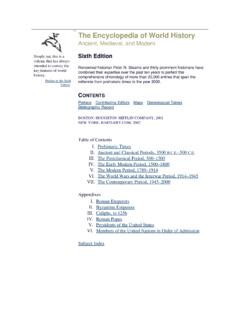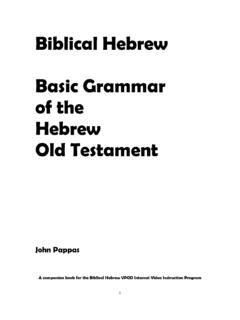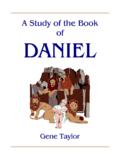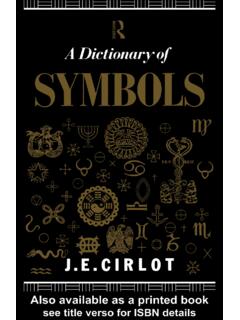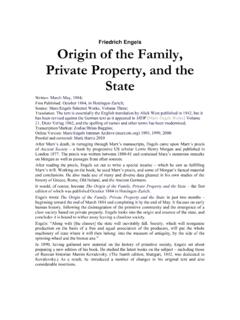Transcription of The Noachian Flood: Universal or Local?
1 The Noachian Flood: Universal or Local? The biblical and scientific evidence pertaining to the subject of a Universal versus localNoachian Flood are discussed in this paper. From a biblical perspective, a universalflood model (and its corollary models: flood geology and the canopy theory) is basedprimarily on: (1) the Universal language of Gen. 6 8, (2) Gen 2:5 6, and (3) thepresumed landing of Noah s ark on the summit of Mount Ararat (Gen. 8:4). It is arguedthat the Universal language of Gen. 6 8 was meant to cover the whole known worldof that time (third millennium BC), not the entire planet Earth, and that thisinterpretation also applies to Gen. 2:5 6 the verses on which the canopy theory isbased. It is also argued that the fifteen cubits upward flood depth mentioned inGen. 7:20 favors a local rather than a Universal a scientific perspective, a Universal flood, flood geology, and canopy theory areentirely without support.
2 The geology of the Mount Ararat region precludes thepremise of flood geologists that all of the sedimentary rock on Earth formed duringthe time of Noah s Flood. The most likely landing place of the ark is considered to havebeen in the vicinity of Jabel Judi (the mountains of Ararat near Cizre, Turkey)within the northern boundary of the Mesopotamian hydrologic basin, rather than on17,000-foot-high Mount Ararat in northeastern Turkey. Since it would have beenlogistically impossible for all animal species on Earth to be gathered by Noah andcontained in the ark, it is concluded that the animals of the ark were those that livedwithin the Mesopotamian region. The archaeological record outside of Mesopotamiaalso does not support a Universal flood model. All of the evidence, both biblical andscientific, leads to the conclusion that the Noachian deluge was a local, rather thanuniversal, Noachian Flood has been one of thesharpest centers of controversy in the longhistory of warfare between biblical theologyand also has been one of the mainstumbling blocks to faith, especially for sci-entists.
3 Was this a Universal flood responsi-ble for all fossils and sedimentary rock onthe face of the Earth, as some biblical literal-ists maintain, or was it a local flood confinedto the limits of mesopotamia ?This paper takes a realistic approach toBible interpretation, as was done in twoearlier articles: The Garden of Eden, a Mod-ern Landscape 2and A Time and a Placefor Noah. 3In the latter paper, an attemptwas made to establish Noah as a real, non-mythical person who lived in Mesopotamiaaround 2900 BC, in what archaeologists referto as the Jemdet Nasr Period (Table 1). In thispaper, Noah also is placed in Mesopotamiaaround 2900 the following discussion, two assump-tions are made using the realistic approach to Bible interpretation:1. The Bible can be taken at face value; thatis, the biblical writer was accuratelyrecording historical events of ancienttimes, viewed within the culture of thosetimes.
4 By taking the Bible at face value, nothing is to be read into the Bible that isnot explicitly stated in its original (auto-graph) on Science and Christian FaithArticleThe Noachian Flood: Universal or Local? All of theevidence, bothbiblical andscientific, leadsto theconclusion thatthe Noachiandeluge was alocal, ratherthan Universal , A. Hillis a consulting geologist who has authored the booksCave Mineralsof the World, Geology of Carlsbad Cavern,andGeology of the DelawareBasin. She is currently pursuing geologic studies in the Grand Canyon. Carolhas been an ASA Member since 1984 and a member of the ASA Affiliation ofGeologists since its foundation. She and her husband Alan are members ofHeights Cumberland Presbyterian Church in Albuquerque, New Mexico. Theyhave two sons, two daughter-in-laws, and three grandchildren. Carol can bereached at: 17 El Arco Dr., Albuquerque, NM 87123 or The scientific disciplines of geology, geography,archaeology, biology, and physics can also accuratelybe applied to the events of ancient EvidenceOne of the basic tenants of many biblical literalists (creationscientists) is that Noah s Flood was a Universal phenome-non that is, flood waters covered the entire planet Earthup to at least the height of Mount Ararat, which is ~17,000feet (5000 m) in elevation.
5 Corollary to this view is theposition held byflood geologists that most of the Earth ssedimentary rocks and fossils were deposited during thedeluge of Noah as described in Genesis 6 8. To explain thisuniversal flood, flood geologists usually invoke thecanopytheory, which hypothesizes that water was held in animmense atmospheric canopy and subterranean deepbetween the time of Creation and Noah s Flood. Then, atthe time of the Flood, both of these water sources weresuddenly released in a deluge of gigantic, Earth-coveringproportions. Along with this catastrophic hydrologicactivity, there was a major geologic change in the crust ofthe Earth: modern mountain ranges rose, sea bottoms splitopen, and continents drifted apart and canyons were cutwith amazing speed. All animals and plants died andbecame encased in flood sediments, and then these fos-sil-bearing sediments became compacted into sedimentaryrock.
6 There are modifications of the canopy scheme, suchas the ice-lens, greenhouse, invisible, and visible canopies,4but essentially the canopy theory claims thatwaters released during Noah s Flood caused all (or most)of the sedimentary and geomorphic features we see todayon planet do creation scientists get their ideas of a plane-tary geology completely at odds with the principles andfindings of modern geology? A Universal flood model isprimarily based on: (1) the Universal language of Gen. 6 8;(2) Gen. 2:5 6; and (3) the presumed landing of Noah s arkon the summit of Ararat (Gen. 8:4), a mountain in north-eastern Turkey (Fig. 1). These three topics will be dis-cussed in this paper, as well as other factors that relate to auniversal versus local model for the Noachian Language of Gen. 6 8 The best argument, biblically speaking, for a worldwideflood is the Universal language used in Gen. 6 8, andthis is no doubt the main reason why people in centuriespast have believed that Genesis was talking about theplanet Earth, and why this traditional interpretation hascontinued to the present day.
7 In Gen. 6 8, earth (eretzorad m h) is used forty-two times, all (k lorkowl) is usedtwenty times, every (alsokowlin Hebrew) is usedtwenty-three times, and under heaven (literally, underthe sky )5is used two The Hebrew for earth used in Gen. 6 8 (and inGen. 2:5 6) iseretz( erets)orad m h, both of which termsliterally mean earth, ground, land, dirt, soil, or country. 6In no way can earth be taken to mean the planet Earth, asin Noah s time and place, people (including the Genesiswriter7) had no concept of Earth as a planet and thus hadno word for it. Their world mainly (but not entirely)encompassed the land of mesopotamia a flat alluvialplain enclosed by the mountains and high ground of Iran,Turkey, Syria, and Saudi Arabia (Fig. 1); , the landsdrained by the four rivers of Eden (Gen. 2:10 14).8 Thebiblical account must be interpreted within the narrowlimit of what was known about the world inthattime,9notwhat is known about the world context also makes it clear that earth does notnecessarily mean the whole Earth.
8 For example, theface ofthe ground, as used in Gen. 7:23 and Gen. 8:8 in place of earth, does not imply the planet Earth. Land is a bettertranslation than earth for the Hebreweretzbecause itextends to the face of the ground we can see around us;that is, what is within our also can refer to aspecific stretch of land in a local geographic or politicalsense. For example, when Zech. 5:6 says all the earth, itisliterally talking about Palestine a tract of land or country,not the whole planet Earth. Similarly, in mesopotamia , theconcept of the land (kalamin Sumerian) seems to haveincluded the entire alluvial is most likely thecorrect interpretation of the term the earth, which isused over and over again in Gen. 6-8: the entire alluvialplain of mesopotamia was inundated with water. Theclincher to the word earth meaning ground or land (andnot the planet Earth) is Gen. 1:10:God called the dry landearth(eretz).
9 If God defined earth as dry land, then soshould , Every, Under these terms also seem toimpart a universality to the Flood event, all three are usedelsewhere in the Bible for local events, and so like the term earth do not necessarily have an all-inclusive or univer-sal meaning. For example, Acts 2:5 states: And there wereVolume 54, Number 3, September 2002171 Carol A. HillTable 1. Archaeological Periods in mesopotamia ~5500 3800 BCUbaid~3800 3100 BCUruk~3100 2900 BCJemdet Nasr~2900 2750 BCEarly Dynastic I~2750 2600 BCEarly Dynastic II~2600 2350 BCEarly Dynastic III~2350 2150 BCDynasty of Akkad~2150 2000 BC3rd Dynasty of Ur~2000 1600 BCOld Babyloniandwelling at Jerusalem Jews, devout men out ofevery nation under heaven. Does this passagemean every nation under the whole sky of theplanet Earth or only the nations that Luke, thewriter of Acts, knew about? Certainly it didnot include North America, South America,or Australia, which were unknown in the firstcentury AD Such Universal language issimply the way people expressed themselvesin those days to emphasize a level of inclu-siveness a type of Bible-speak that is notsupposed to be taken absolutely literally, butin the context of what the biblical author wastrying to emphasize.
10 This passage in Actssimply means that devout men (Jews) ofmany nations from some extended region ofthe then-known world were present at Jeru-salem. The Apostle Paul uses similar hyper-bolic language in Col. 1 excellent example of how a Universal Bible-speak is used in Genesis to describea non- Universal , regional event is Gen. 41:46: And the famine was over all the face of theearth. This is the exact same language asused in Gen. 6:7, 7:3, 7:4, 8:9 and elsewherewhen describing the Genesis Flood. All(kowl) the face of the earth has the samemeaning as the face of the whole (alsokowl)earth. So was Moses claiming that thewhole planet Earth (North America, Austra-lia, etc.) was experiencing famine? No, theuniversality of this verse applied only to thelands of the Near East (Egypt, Palestine, mesopotamia ), and perhaps even the Medi-terranean area; , the wholeknownworldat that same principle of a limited Universal -ity in Gen.











